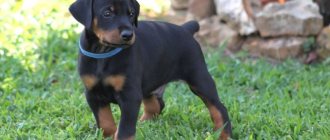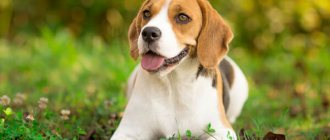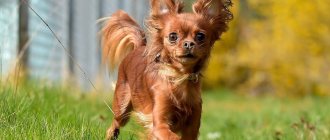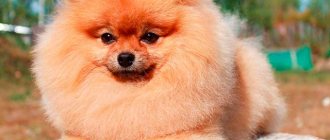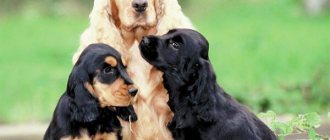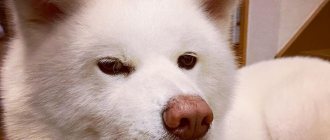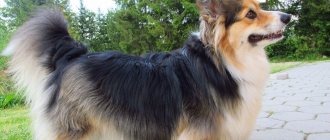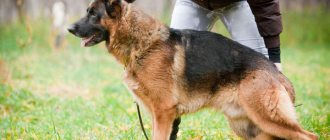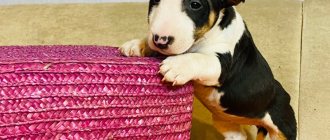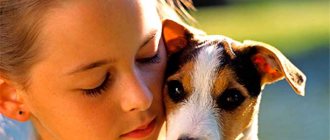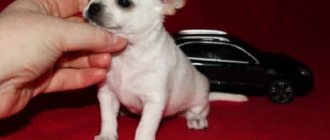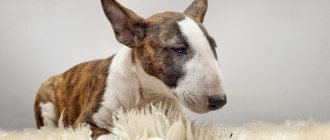If you decide to get yourself a Shiba Inu dog, we recommend that you first read the reviews of Shiba Inu owners.
The Japanese Shiba Inu dog breed was known more than two thousand years ago.
These dogs are distinguished by their wayward character, reflecting a slightly Japanese mentality that is not familiar to us.
Initially, Shibo Inu were bred as hunting assistants, but nowadays, dogs of this breed are bred as companions for living together and being active.
Description of the breed
Shiba Inus are one of the smallest Japanese dogs with a strong, muscular body and toned abdomen.
If we talk about the size of the Shiba Inu, then the representatives of this breed have pronounced sexual dimorphism. The height of adult males is 38-41 cm and weighs 10-13 kg; females grow at the withers to 35-38 cm and weigh 7-9 kg .
They have a wide head with a pronounced transition from the forehead to the muzzle, slightly slanted almond-shaped eyes of brown color and triangular erect ears. The limbs are strong, the tail is thick, set high.
Representatives of this breed have a three-layer coat: at first the coat is longer and coarser, then shorter and softer, and at the end there is a soft undercoat..
There are quite a few color options: red, black and tan, sesame, black sesame, red sesame, sesame, brindle, white.
The peculiarity of the Shiba Inu lies in their unique facial expressions: these dogs can smile and express many other emotions.
For a novice trainer
To prevent training from turning into torture:
- Take your pet for a walk beforehand. A tired, running dog is less distracted. The effect will be greater. Active walking makes working with the animal easier.
- The command is spoken once.
- Take pauses. When practicing, for example, “near”, “lie down”, “fetch”, you need to give the dog time to take a breath. 5-10 seconds will be enough.
- Change the sequence. If the dog gets used to doing everything in order. That, for example, after “to me” you need to “sit.”
- You can't overload it. Too intense training can harm the animal.
An already trained dog follows commands under any conditions. But your pet may get tired.
- Sometimes students, like ordinary schoolchildren, “run away from class.” They may be distracted by a nearby cat or other animal. Be more careful with your exposure. Train her on a long leash. This will allow you to catch up with the “mischievous person”, even if he runs fast. A leash with a carabiner for 3-5 meters is suitable. Often such a leash is just needed for endurance and training to pick up “goodies” from the floor.
- “Mass” training is not allowed. Only the owner should act as a trainer. Otherwise the dog will be distracted.
- It's worth pausing. If the animal doubts the correctness of the actions, the reason is the load. Give your dog a simple command and then praise generously. When she sees that the owner approves of him, she will begin to perform the exercises better. Play or take a walk with her.
- Commands are studied systematically and gradually. You need to train your pet to obey in any conditions. Start in a quiet place, gradually adding more “stimulants.” Create them. For example, scatter treats, call a friend to pass by the training place.
To train an animal, you need to be patient and perform the exercises systematically.
Pet character
Shiba Inus have a difficult character , which not everyone can cope with .
These dogs are stubborn and independent, which can seriously complicate the process of education and training - if the pet does not want to do something, then it is almost impossible to persuade or force it.
To people unfamiliar with this breed, it may seem that Shiba Inus are gloomy, unsociable dogs that prefer to always be alone. This is not entirely true.
They really need peace and a place where they can hide from prying eyes, but at the same time they are devoted to their owner and love him, they are just not prone to strong displays of emotions.
Only a person with a strong, strong-willed character can become a master for a Shiba Inu, in whom he will see the leader of the pack, a leader.
At the same time, it is necessary to show the pet that he is not the main one in the house as early as possible, but in such a way as not to belittle his dignity: Shiba Inu only accept communication on equal terms and will not obey.
CAREFULLY!
Due to the preserved instincts used by these dogs in hunting, Shiba Inu are quite aggressive towards other animals and people; only early socialization can change this.
Representatives of this breed are good watchmen and security guards, they are active and hardy and will become good companions for people leading an active lifestyle.
What to feed?
The basics of feeding dogs are relatively simple. To determine the serving size, consider your pet's body weight . Then make adjustments based on your activity level.
The food can be natural and dry:
- In a natural diet, the main ingredients should be meat and fish. Porridge occupies the second most important place in the Shiba Inu diet, because it is not only a source of protein, but also carbohydrates. Vegetables and fruits are also needed, but in small quantities.
- Industrial food contains everything necessary for the healthy development of your pet.
There are concentrates that are given dry or after soaking in broth or water. The dog gets used to the food, so do not change it too often. This may lead to indigestion.
Adult dog
Like all living things (including you!), dogs require a balance of certain nutrients in their diet to maintain health and longevity. Food quality matters! The most important elements for dogs are proteins and fats:
- Protein is made up of amino acids, which provide the building blocks for healthy cells, tissues and muscles. Helps maintain muscle mass.
- Fat plays a role in the absorption of nutrients and the production of hormones. It is also a highly concentrated source of energy for your dog.
Carbohydrates should be included in the diet of an adult dog, but in limited quantities. Consumption helps improve the functioning of the body, prevents diabetes and obesity.
Important! Eating grains (millet, barley and others) by your dog can be dangerous! The high glycemic index of these foods leads to a sharp spike in blood sugar.
Feed twice a day.
Puppy
Protein and fat are also important elements in a puppy's diet. The nutrition of a growing body should be no less varied than that of an adult. Inexperienced owners often wonder what volume of portions should be given.
Overfeeding and underfeeding are equally harmful for fragile puppies. Carefully watch how the babies eat - this will make it easier for you to understand whether there is enough food or too much. Puppies up to ten months are fed no more than six times a day, increasing the portion size over time. Upon reaching ten months of age, they are fed twice a day, like an adult dog.
Important! Add special additives to your puppy's food. For example, calcium or fatty acids will help form strong bone tissue and ensure healthy growth.
Natural food
Foods rich in proteins and fats:
- boiled and raw meat scalded with boiling water (beef, rabbit, poultry);
- sea fish (salmon, tuna, etc. - always heat-treated);
- dairy: cottage cheese, kefir, low-fat sour cream;
- boiled chicken egg;
- soup sets (heart, kidneys, liver, bird giblets, etc.);
Carbohydrates:
- vegetables and fruits in small quantities (boiled potatoes, cauliflower, carrots, zucchini, pumpkin, etc.);
- porridge (buckwheat, rice, semolina).
Important! You can’t give sweets and smoked foods! They harm digestion!
Advantages and disadvantages
The advantages of the Shiba Inu include::
- devotion;
- strength and endurance;
- cleanliness;
- unpretentiousness;
- protective instinct;
- ability to get along with children;
- easy care;
- unobtrusiveness;
- mind;
- friendliness;
- possibility of apartment maintenance;
- courage.
Among the disadvantages of representatives of this breed are::
- complex nature;
- stubbornness;
- possibility of aggressive behavior;
- cunning;
- heavy shedding;
- predisposition to allergic reactions;
- tendency to damage things;
- independence.
To correct the negative character traits of the Shiba Inu, early socialization and proper education are necessary.
Is it possible to train guard duty?
Quite often, given the size of the dog, owners expect it to be a good guard. However, the Akita is not a guard dog. Representatives of the Akita Inu breed are truly ready to fight with any living creature in order to protect their owner. But first of all, it is a hunting dog.
If you begin to actively train an Akita to guard and attack, the dog may begin to attack all unfamiliar people approaching the house.
The best Bengal cat in Moscow
The owner’s task is to teach the dog to vocalize when it sees a stranger. Teaching should be done through examples and simulated situations. It is best for the Akita to observe the behavior of another adult dog when it sees a stranger.
Who to choose - a boy or a girl?
decide on the desired gender of your Shiba Inu puppy before purchasing it . Males and females have some differences in character, their advantages and disadvantages.
Thus, buying a male dog eliminates the possibility of encountering problems such as estrus, childbirth and false pregnancy. Boys' security qualities are more pronounced; they are bolder and more desperate.
In addition, the cost of males is lower. At the same time, male dogs react year-round to any female dog in heat, react aggressively to other male dogs and tend to start fights.
Bitches are more gentle and affectionate, they are more obedient, they become more attached to their owner, they get along better with children, becoming good nannies for them..
But estrus, which occurs 1-2 times a year, provokes some changes in the behavior of dogs: they become disobedient, nervous, and can show aggression.
To breed the breed, it is better to purchase a bitch - you can breed almost any dog, the main thing is that she has the necessary documents and an exhibition score of at least 4.5 points.
History of origin
Dogs similar to the Shiba Inu lived in Japan at the dawn of civilization, more than 2.5 thousand years ago. This is evidenced by numerous figurines found by archaeologists during excavations. True, the dog was originally larger. However, after hunting dogs began to be imported to Japan, her appearance began to gradually change. The Shiba Inu became smaller and was often used for hunting in difficult bushes. In its homeland, this dog is still called the “bush dog.”
The history of the Shiba Inu began on the Japanese island of Honshu. The Shiba Inu probably inherited the blood of the Chow Chow and Kishu. At the beginning of the 20th century. Purebred Shiba Inus have become rare. During World War II the breed almost disappeared. Now it is becoming popular in Japan. The Shiba Inu received absolute recognition and the name of the breed in 1936.
Good or evil? How does he treat children?
Despite the possibility of aggressive behavior with strangers and other people's dogs, Shiba Inus cannot be called evil - they are good-natured dogs that love their owner and his family members.
Representatives of this breed love children and treat them with care and attention..
Younger family members for the Shiba Inu are an object of protection and protection.
IMPORTANT!
However, if a child comes into the family when the dog has already grown up, then it is unlikely that a friendly relationship will be established between them; rather, the dog will simply treat the baby with patient condescension.
Nicknames for Shiba Inu
The pet can be called by any euphonious name of several syllables. It should be clear and easy to understand, so versions from the dog passport that are too long will have to be shortened.
As a rule, Shibu is called Japanese names with an unusual meaning:
A nickname for a Shiba Inu boy can emphasize his strong-willed qualities and impressive appearance:
- Fugue – elegant;
- Taishi – ambitious;
- Hiro is a hero;
- Ken – strong;
- Kabuto - Japanese helmet;
- Heishin is the favorite;
- Izamu – brave;
- Mamoru is a protector;
- Takeshi – noble;
- Yasuo is honest.
Names for Shiba Inu girls may have a softer meaning:
- Momo – peach;
- Ai – love;
- Makoto – sincere;
- Ren – water lily;
- Kaoru – aroma;
- Hana – flower;
- June – obedient;
- Hoshi – star;
- Minako is a beautiful child;
- Chow is a butterfly.
Related materials:
Shiba Inu | breed | dog | Dogs | Japan | Russia | house | Interesting facts | Parenting | vigilance | friend | fun | animals | attention
Articles
- Dog breeds: Shikoku Inu December 09, 2014, 13:00
- Dog breeds: Kai-ken January 19, 2015, 20:00
- City Grozniy. The road to dream and reality. Part II August 29, 2015, 18:00
Video
- Fragrance notes: lavender August 31, 2010, 10:39 am
- Fragrance notes: cumin September 14, 2010, 00:00
- Fragrance notes: fig September 21, 2010, 00:00
Diseases
Common diseases to which the breed is prone:
Glaucoma. This is a disease that slowly destroys the optic nerve of the eye. Most often, it is associated with a buildup of fluid that creates an obstruction in the front of the eye. Although the different types of glaucoma vary in severity, they are almost always treatable. If left untreated, the disease causes partial loss of vision or complete blindness. However, various eye drops can help stop the fluid from accumulating. There are also several types of operations that successfully solve the problem. Progressive retinal atrophy. This is another disease that affects the eyes. It is often associated with genetics. The photoreceptors in the back of the eye begin to fail, making it difficult to see in the dark. As the disease progresses, vision deteriorates. Dogs begin to see poorly even in bright daylight. Unfortunately, without treatment, complete blindness occurs. The best option is to diagnose a predisposition to the disease at an early age. Legg-Calvé-Perthes disease. With this disease, the ligament in the knee is weak and the dislocation leads to the displacement of the kneecap. Shiba Inu may be genetically predisposed to this condition, or may acquire it as a result of various injuries. The severity of patellar luxation varies greatly. In some cases it is minor, and in other cases correction is required. Symptoms include abnormal gait, pain when walking, lameness in the leg(s) and, in the worst cases, immobility. Depending on the severity, there are many different ways to treat a luxated cup. It is never life threatening. But without specific treatment, the dog will constantly suffer. Hypothyroidism. This condition occurs when a dog's thyroid gland does not develop properly. Symptoms: the animal becomes lethargic, obese, and hair falls out. In some cases, there is an excessive need to urinate
If you suspect something is wrong with your pet, it is important to have him tested for hypothyroidism. Without treatment, this can lead to very serious consequences.
However, once the diagnosis is made, the dog's life can be improved with the help of medications. Cramps. Convulsions in animals are completely different from those in humans. The pet can run non-stop, hide in corners in complete confusion, bark, and not notice anything. Seizures are usually not life-threatening in dogs, but they can also indicate a more serious problem. Therefore, it is important to take your friend to the vet. This condition can often be treated with medication. Allergies. Symptoms: runny nose, swollen eyes, dog sneezes excessively. Allergies can be to food, certain substances (such as shampoos or cleaning products), air pollution, and more. Your veterinarian should diagnose the cause of the allergy and then prescribe the recommended treatment. Hydrothorax. This condition occurs when fluid accumulates in the chest. It can cause loss of appetite, extreme fatigue, difficulty breathing, coughing and shortness of breath, and weakness. It is usually treated by removing fluids and introducing a low-fat diet. In more severe cases, surgery is required.
Learn basic commands yourself
The method of training Akita Inu is no different from training other breeds. The main thing is not to shout or punish your pet.
To a patient and loving owner, this dog will reciprocate.
To me
This command is best learned when the puppy is calm. Call your pet by name, adding “Come to me!” and showing off the treat. When he approaches, praise him and give him a treat. Number of repetitions – 5–6 times. The command is given in a joyful or affectionate voice.
When the child begins to perform the required task confidently, the exercise is complicated by adding distractions. For example, one of the family members will offer the baby a toy or other interesting item
It is important that the puppy follows the command no matter what, because a variety of situations happen on the street
Sit
Say the command “Sit!” The treat is held above the puppy's head so that he has to sit down to receive the treat. If your pet doesn't understand, lightly press the sacrum with your other hand.
The exercise is repeated 3-4 times. To reinforce it, it is served in convenient situations: before feeding, before going for a walk, or, if necessary, to calm the dog down.
Lie
The command is taught according to the same principle as “Sit!”, only the treat is moved downwards. To make it easier for the puppy to understand what they want from him, you can lightly press on his shoulder blades.
It is useful to accompany the voice command with gestures.
For "Down!" the generally accepted analogue is a raised hand. This may be necessary when the command is given from afar.
Wait
Show your dog a treat, sit him down, and then give the command “Wait!” Take a few steps back. If the dog follows you, command “Sit!” again. Unlearning requires a certain amount of patience.
It’s useful to practice “Wait!” in various situations: in front of the door, when the dog wants to jump out in front of the owner, when guests arrive, when the pet is eager to greet them.
It is forbidden
Sit your dog down and place a treat in front of him. As soon as the pet reaches for it, give a prohibiting command. If the puppy does not obey, cover the treat with your hand and repeat the prohibition.
Near
The command is learned while the dog is walking on a leash next to the owner. Ideally, the pet should follow exactly in step with the owner. The man holds his hand on his hip with a tasty treat clutched in it, commanding “Near!” and keeps going.
If the puppy tries to get ahead, he is shown a treat and the command is repeated. A treat is given when the dog follows the command correctly. In the future, the exercise becomes more complicated by eliminating the leash.
Place
The command must be repeated every time the owner sends the puppy to the bed. As soon as the baby understands where his place is, the exercise can be changed: give a command when the puppy is at a distance from the bed, accompanying the vocal feed with a gesture in the required direction.
Aport
The command will be especially useful if the owner wants to raise the Akita Inu to be a hunter. It is better to practice the exercise in the fresh air.
It is recommended to use a toy with a smell as an object to be retrieved. The first throws should be a short distance. To make it more difficult, the distance is increased and the items being imported are changed so that the dog does not develop a connection with only one object.
Barrier
When practicing a command, it is better to run and jump with your pet. A low barrier (up to 25 cm) is suitable for this. Subsequently, the exercise becomes more complicated due to the fact that the owner stands on the other side of the fence with a treat in his hand.
Color variations - the most popular colors
The coat of the breed has coarse guard hair and a lush soft undercoat. The longest fur is on the tail of an animal. In accordance with the standards, three color options are allowed:
- ginger;
- black and tan;
- zonal (sesame or sezar).
The first is considered the most popular, the other two account for about 20% of animals. Regardless of the main option, “urajiro” (“urajiro”) is considered mandatory - the presence of white hair on the throat, neck, tail and paws. White fragments should also be present on the sides of the muzzle and under the belly.
Important! The most valuable are Shibo Inu dogs with bright, rich colors. However, light versions of red tones - sand, peach - are also allowed by the standard
White representatives of the breed are very beautiful, but they are not recognized by the standard, therefore they are not allowed for breeding and exhibition activities.
Charming Shiba Inus will become faithful companions for family people
General principles of animal training
To successfully train a pet, systematic training is necessary. The duration of the lesson should not exceed 2 hours. Commands for dogs: the list of techniques practiced in the lesson depends on the level of training of the animal; for example, a Labrador puppy begins to be trained from the first months. Gradually the number of teams should be increased.
New techniques are practiced in the first part of the lesson. After each command, a three-minute break is required for the pet.
Rules for successfully training a puppy:
- Techniques performed correctly should be reinforced with praise and encouragement.
- It is better to voice the instruction once, accompanied by a gesture.
- Maintaining consistency in orders and gestures.
- The first classes are conducted in a familiar environment, then change the environment.
- The trainer and the dog are in a good mood.
- It is better to end the lesson with an instruction that the puppy does better than others.
Common mistakes when training
- The dog is unconscious of its actions and does not understand human speech. When giving a command, you cannot talk; conditioned reflexes are inhibited. All commands are pronounced without further ado.
- Violations of the order of skill development. From simple to complex. Until the dog has mastered a certain command well, you cannot proceed to the next one.
- The dog handler does not take into account the characteristics of the animal, which reduces the effectiveness of training.
- Retraining. Frequently practicing the same skills helps to fatigue, reduce performance and overload the nervous system. Once the technique is learned, it is no longer performed that day. If she refuses to perform a skill as a result of overtraining, then she is given a rest for 2-3 weeks. Dog handlers monitor the condition of the dog during training.
- Incorrect voice intonation changes the sound of the command. You cannot pronounce everything in one intonation, otherwise it loses its significance as an irritant. The dog will stop responding to her.
- Incorrect use of directions. You can’t repeat it often, otherwise you’ll develop the skill of doing it when you repeat it.
Best Large Dog Breeds with Photos and Names
